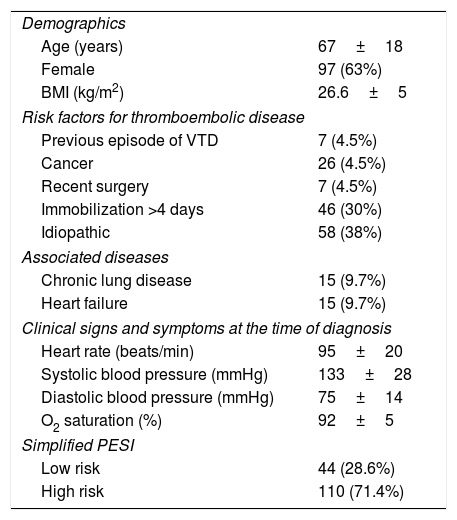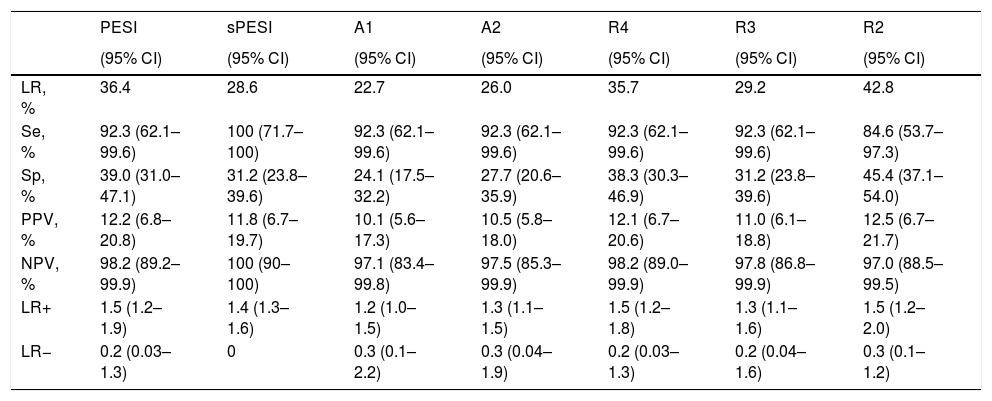To determine the accuracy of clinical gestalt to identify patients with acute symptomatic pulmonary embolism (PE) at low-risk for short-term complications.
Patients and methodsThis study included a total of 154 consecutive patients diagnosed with acute symptomatic PE in a tertiary university hospital. We compared the prognostic accuracy of the Pulmonary Embolism Severity Index (PESI), the simplified PESI (sPESI), and clinical gestalt of (1) 2 senior physicians (one with and one without experience in the management of patients with PE), (2) a fourth-year resident of Pneumology, (3) a third-year resident of Pneumology, and (4) a second-year resident of Pneumology. The primary outcome was all-cause mortality during the first month after the diagnosis of PE.
ResultsThirty-day all-cause mortality was 8.4% (13/154; 8.4%; 95% confidence interval [CI], 4.1–12.8%). The PESI and clinical gestalt classified more patients as low-risk, compared to the sPESI (36.4%, 31.3% and 28.6%, respectively). There were no deaths in the sPESI low-risk category (negative predictive value 100%). Prognostic accuracy increased with increasing experience (84.6 vs. 92.3%; p=0.049).
ConclusionsThe sPESI showed the best accuracy at correctly identifying low-risk patients with acute symptomatic PE. Clinical gestalt is not inferior to standardized clinical prediction rules to prognosticate patients with acute PE.
Determinar la utilidad de la estratificación pronóstica empírica para identificar a pacientes con tromboembolia de pulmón (TEP) aguda sintomática y bajo riesgo de complicaciones precoces.
Pacientes y métodosEste estudio incluyó a un total de 154 pacientes consecutivos diagnosticados de TEP aguda sintomática en un hospital universitario terciario. Comparamos la capacidad pronóstica de la escala clínica Pulmonary Embolism Severity Index (PESI), la escala PESI simplificada (PESIs) y la evaluación empírica de: 1) 2médicos adjuntos (uno con y otro sin experiencia en el manejo de pacientes con TEP); 2) un residente de cuarto año de Neumología; 3) un residente de tercer año de Neumología, y 4) un residente de segundo año de Neumología. El evento primario de mal pronóstico fue la mortalidad por todas las causas durante el primer mes después del diagnóstico de la TEP.
ResultadosDurante los primeros 30 días después del diagnóstico de la TEP se produjo el fallecimiento de 13 pacientes (8,4%; intervalo confianza [IC] del 95%, 4,1-12,8%). Hubo una tendencia (no estadísticamente significativa) a clasificar más pacientes de bajo riesgo mediante la escala PESI o la evaluación empírica que con la escala PESIs (36,4, 31,3 y 28,6%, respectivamente). No se produjo ningún evento en el grupo de pacientes de bajo riesgo según la escala PESIs. Se detectó una mayor eficacia pronóstica de la estratificación empírica conforme mayor fue la experiencia clínica de los evaluadores (84,6 vs. 92,3%; p=0,049).
ConclusionesLa escala PESIs es la herramienta más eficaz para identificar pacientes con TEP aguda sintomática y bajo riesgo de muerte por todas las causas durante el primer mes de seguimiento. La evaluación pronóstica empírica realizada por médicos experimentados no es menos eficaz que la realizada mediante escalas estandarizadas.








